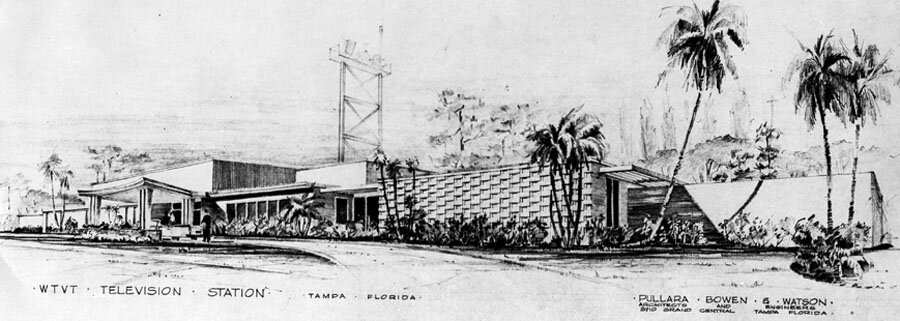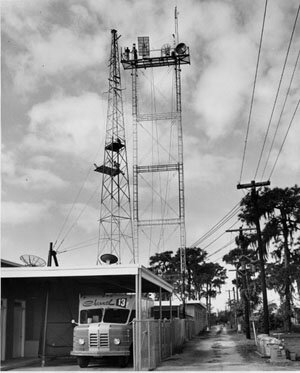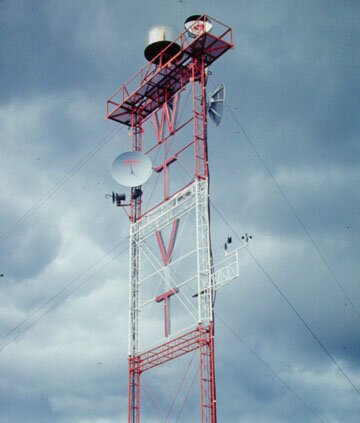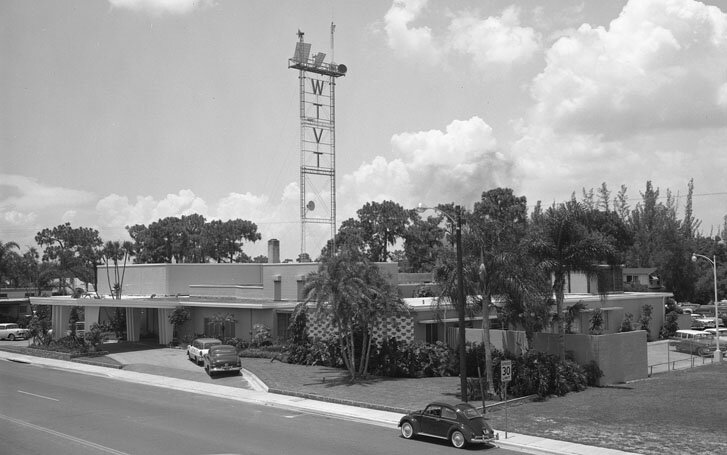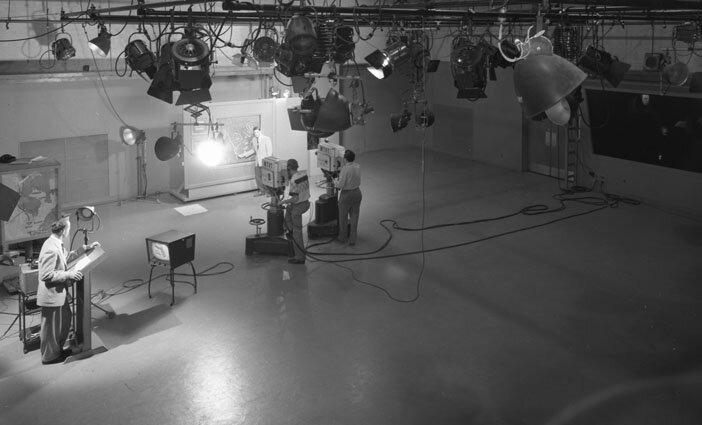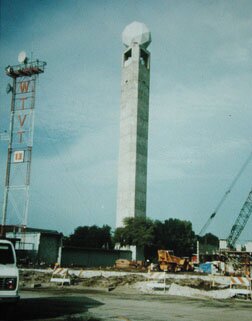|
WTVT's Tampa Studio/Tower |
WTVT's original building in 1956.
A former Greek restaurant was hastily converted into Channel 13's first studio facility in early 1955. Offices were placed in what was formerly a kitchen, and the dining room became the stations one and only studio. WTVT began broadcasting on April 1, 1955, and became an overnight success in the burgeoning Tampa Bay television market.
As WTVT employees strained to work in the relatively confined studio and makeshift offices, a major change in management would soon take the facility to a new level. In August of 1956, the original owners of WTVT, Walter Tison's Tampa TV Company, sold Channel 13 for around $3,500,000 to the WKY Radiophone Company, a unit of the Oklahoma Publishing Company and publisher of Oklahoma City's daily newspaper. Later known as Gaylord Broadcasting, the company brought fresh capital to WTVT and a new General Manager from WKY-TV, P.A. "Buddy" Sugg. Sugg revealed plans to expand the crowded facility, which was fortunately situated on a large piece of property - - about 1 city block square. There would mean plenty of room for future expansion.
This 1956 plan takes the original restaurant and adds a studio and office space.
The building would serve until its demolition in 1989.
On the station's west wing, the new Studio B would accommodate larger productions. Offices for traffic and production would border Studio B on the second floor. On the east wing, new offices would be built for the station's management, along with a conference room and screening room.
Most notable in the plan is the twin tower holding microwave equipment and weather instruments. The tower as illustrated is much shorter than the final 150 foot version, and does not bear the station's call letters or Roy Leep's domed radar unit.
Almost ready! The new WTVT takes shape over the summer of 1957.
WTVT's signature twin tower would be replacing the original single-masted version used since 1955. Atypical in design and totally unique, the twin tower would literally put WTVT on the map. Because of Florida's flat topography, the tower could be seen from a good distance.
|
|
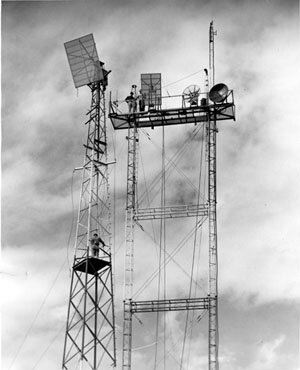 |
At left, the new twin tower under construction. Note the original mobile unit parked below, and the single-mast tower used to microwave signals to the main transmitter in Baum. There are no satellite reception dishes, since it will be 1962 before the first communication satellite (Telstar) is launched into orbit.
The Twin Tower in 1966. Note Roy Leep's original radar with plexiglass dome,
and a microwave receiver aimed at the St. Pete studio
The new twin tower antenna housed a microwave receiver (for remote reception) and a microwave transmitter aimed at the main transmitter in Baum. Roy Leep's new radar, so powerful that its range covered all of Florida, was positioned at the top and center of the tower in 1961. Shortwave antenna for radio/telephone communication with reporters sat adjacent to the radar. Finally, the tower was used as a terrific marketing tool. The call letters were positioned vertically, and read correctly when seen from either east or west.
The expanded studio in 1957. Minor alterations to the tower (the addition of Roy Leep's radar) and the portico entrance (Channel 13 signage) were the only changes visible from Grand Central Blvd. in ensuing years.
The production staff was grateful to gain a new, larger studio. The original 'dining room' studio was labeled Studio A, and the new, two story studio became Studio B. Studio B's dimensions, around 49' x 62' feet, was a vast improvement in space for production. Two additional RCA cameras were purchased for the new studio and mounted on Houston Fearless pedestals capable of changing height electrically at the touch of a switch. The control room serving both studios was neatly placed between Studios A and B, with angled-glass positioned so that the producers, directors, and audio engineers could easily see into either studio. The entire renovation would be completed by August of 1957.
A brand-new studio for WTVT. Measuring 49' by 62'. Roy Leep can be seen delivering a weather forecast. At far right is the control room, hidden behind slanted glass panels.
Studio B would be the main production studio for "Popeye Playhouse," (left)
"3-D Danny," and at various times "Good Day with Ernie Lee",
Pulse News, (right) Sports, and Weather.
Salty Sol's sportscast from Studio B as seen from the new control room.
The improved studios served Channel 13 for another thirty two years. 'Mary Ellen,' 'Shock Theatre,' 'High-Q,' 'College Kaleidoscope,' 'Breakfast Beat,' 'Church Service,' 'Black Contact,' 'Pulse Plus,' and thousands of commercials were produced out of Studio B. In the early 1970's, a cloth cyclorama was placed on the southern wall. Although the cyc provided a pleasant backdrop for musical numbers, it took away valuable floor space.
The two photos of Studio B shown below were taken from almost identical angles, demonstrating the completely different setups possible in the same studio space!
One Saturday every month during the school year, HIGH-Q
was taped in Studio B. Announcer Dean Drapin is seen in foreground.
Studio B served many purposes, as shown here during election
returns in 1972. Richard Bozeman is operating the G.E. PE-400 camera.
A footnote: The original 1955 transmitter in Riverview was 860 feet high. A new transmitter went on-line in the fall of 1966. Costing $1,250,000, the new antenna was 1,549 feet tall and located about 5 miles southeast of Riverview in Balm. At the time, it was the highest man-made structure in Florida and increased Channel 13's coverage area while improving picture quality.
Back at the Tampa facility, STUDIO 13 was added in 1976 to expand the station's commercial production capability.
THE END OF AN ERA
Gaylord sold WTVT in 1987 to Gillette Communications. In 1989, a new facility was constructed adjacent to the original building that was home to Channel 13 since 1955. Once the transfer of personnel and equipment was complete, the old building, along with the classic 'Twin Tower,' was razed.
Out with the old, in with the new.
The original 'Twin Tower's' days are numbered as the new Channel 13 facility takes shape.
